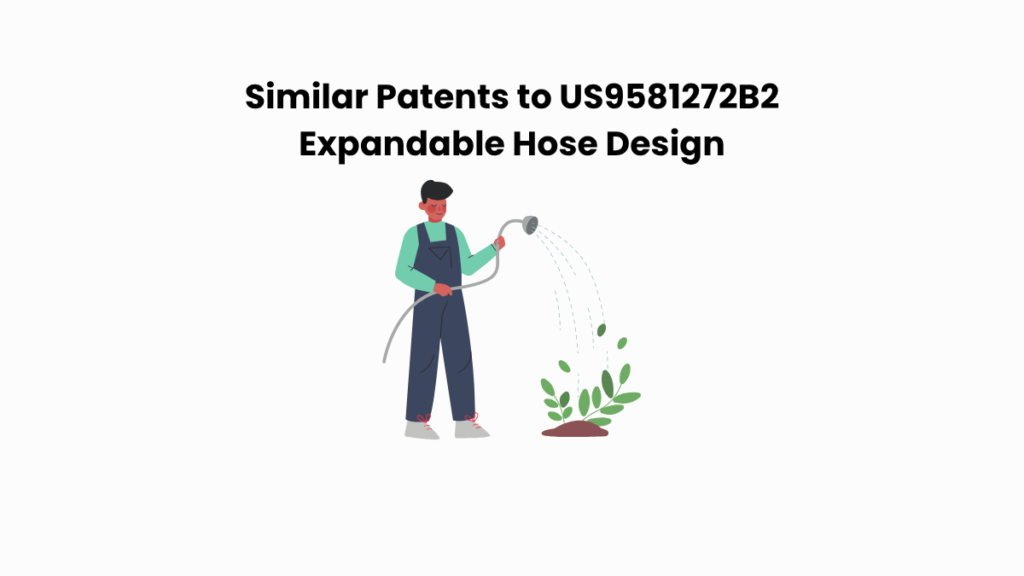Some inventions quietly improve daily life. Others, like US9581272B2, earn attention for rethinking the familiar.
In a recent dispute between Telebrands Corp. and Ningbo Fine Source Imp&Exp Co., Ltd., this expandable garden hose patent has come under renewed attention. But beyond the courtroom, what makes this invention compelling is its clever engineering. It features a flexible hose that expands under water pressure and contracts when not in use. The design uses a dual-layer structure and a pressure-equalizing flow restrictor.
In this article, we turn to the Global Patent Search (GPS) platform to explore similar innovations in hose design and water delivery systems. Our focus isn’t on litigation. It’s on surfacing relevant patent references. Whether you’re working in product design, patent strategy, or IP research, this deep dive offers a data-driven perspective into the technologies surrounding US9581272B2.
Understanding Patent US9581272B2
US9581272B2 covers a flexible, expandable garden hose system designed for efficient water delivery and compact storage. The invention features an inner elastic tube housed within a fabric-like outer layer. When water flows into the hose under pressure, the inner tube expands both in length and width, causing the hose to extend. When the pressure is released, the hose contracts automatically to a shortened, easy-to-store length. A built-in flow restrictor near the outlet helps regulate water pressure and contributes to the hose’s expansion behavior.
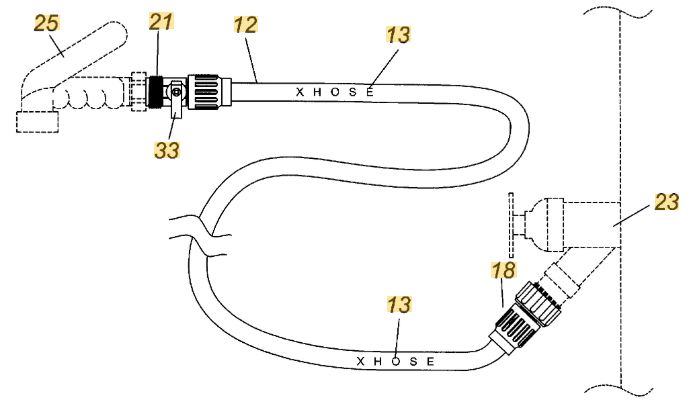
Source: Google Patents
Its four key features are
#1. Dual-tube construction: An elastic inner tube made of thermoplastic elastomer is housed within a flexible outer tube made of woven or braided fabric.
#2. Pressure-responsive expansion: The hose expands longitudinally and laterally when pressurized water is introduced and contracts when the pressure is released.
#3. Integrated flow restrictor: A flow restrictor is built into the outlet coupler to help build internal pressure and control expansion.
#4. Non-bonded midsection: The inner and outer tubes are only connected at the inlet and outlet couplers, allowing independent movement during expansion and contraction.
This design addresses common issues in conventional hoses, such as kinking, bulkiness, and storage limitations. It offers a lightweight, user-friendly alternative that adapts to changing water pressure with minimal effort.
Note: Water recreation depends on flow precision. EP2728089B1 and 5 Similar Patents Powering Artificial Waves in Pools show chamber-based sequencing that transforms raw water pressure into custom surf experiences.
Similar Patents As US9581272B2
To explore the innovation landscape surrounding US9581272B2, we ran the patent through the Global Patent Search tool. Below is a quick glimpse of the GPS tool in action:
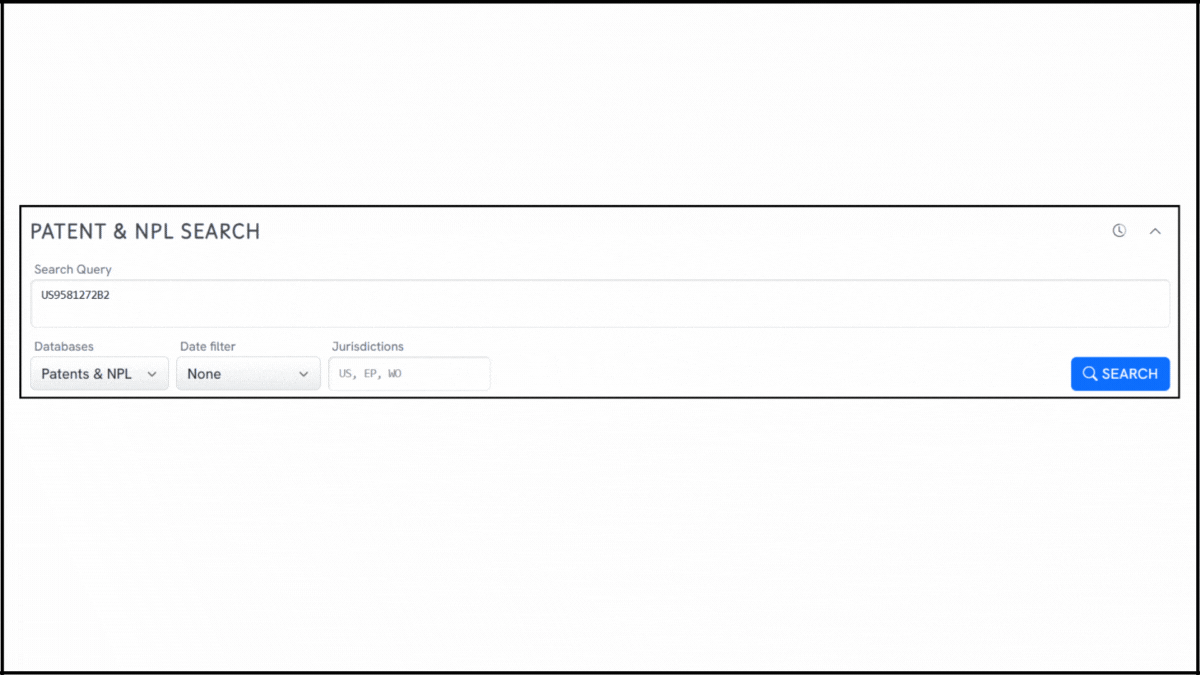
Source: Global Patent Search
This analysis surfaced a set of related patents that share structural and functional design principles with the expandable hose in question. Below, we highlight four of these references that reflect comparable approaches in hose expansion, fluid control, and dual-tube construction. Each offers a lens into how similar design problems have been addressed across other systems.
#1. US20130087205A1
This US patent, US20130087205A1, published in 2013, introduces an expandable hose assembly that uses internal water pressure to stretch an elastic inner tube housed within a flexible, non-elastic outer sleeve. It emphasizes a secure coupling method, high-pressure handling, and automatic contraction once the water source is turned off.
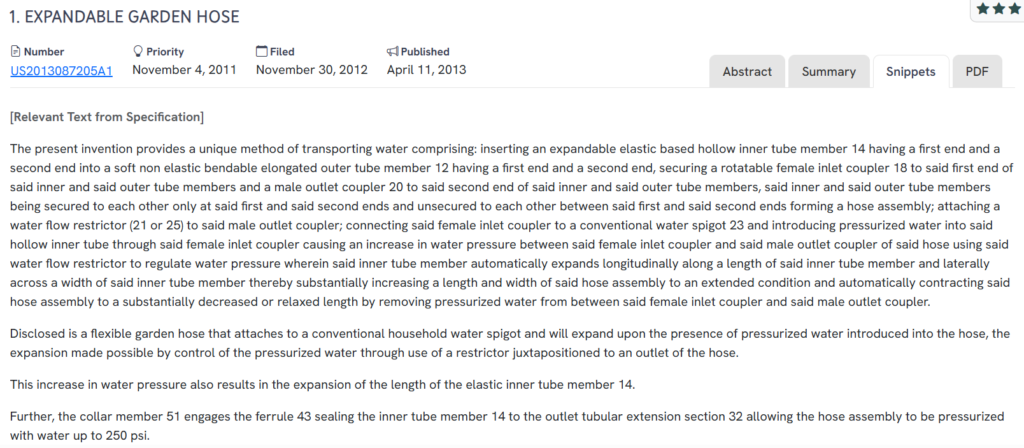
Source: GPS
What this patent introduces to the landscape?
- Elastic inner tube inside a non-elastic outer sleeve – The inner tube expands in both length and diameter, while the outer sleeve defines the expansion limits.
- Pressure control via integrated flow restrictor – A restrictor near the outlet helps maintain internal pressure and manage expansion.
- End-only tube attachment – The inner and outer tubes are secured only at their ends, allowing free movement between layers.
- High-pressure endurance – The hose assembly is designed to handle water pressures up to 250 psi.
- Automatic contraction feature – The hose retracts to a compact form when water pressure is released, improving ease of storage.
Related Read: US7353555B2 shows an inflatable mattress with a raised frame and Y-shaped beams that stop bulging and sagging. It’s a clean example of using internal structure to keep soft goods under pressure stable.
How it connects to US9581272B2?
- Both systems employ a dual-tube structure, using an elastic inner tube and a fabric outer sleeve for pressure-responsive expansion.
- Each design features a flow restrictor mechanism at the outlet to regulate water pressure and ensure full extension.
- Both hoses attach the inner and outer tubes only at the couplers, allowing the outer sleeve to move freely and contract naturally.
If you are interested in home appliances, you can explore our patent analysis of US9907453B2 that reinvents Dish Drying for Small Kitchens
Why this matters?
This reference reinforces the design strategy of using internal pressure to manage hose expansion while maintaining user control and flexibility. Its emphasis on high-pressure tolerance and structural simplicity makes it a strong technical peer to US9581272B2.
#2. CA2779882A1
This Canadian patent, CA2779882A1, published in 2013, introduces a pressure-sensitive hose system that expands both longitudinally and laterally under fluid pressure. The design relies on an elastic inner tube housed inside a non-elastic outer sleeve, with a structure that supports flexible performance while minimizing wear and tear.
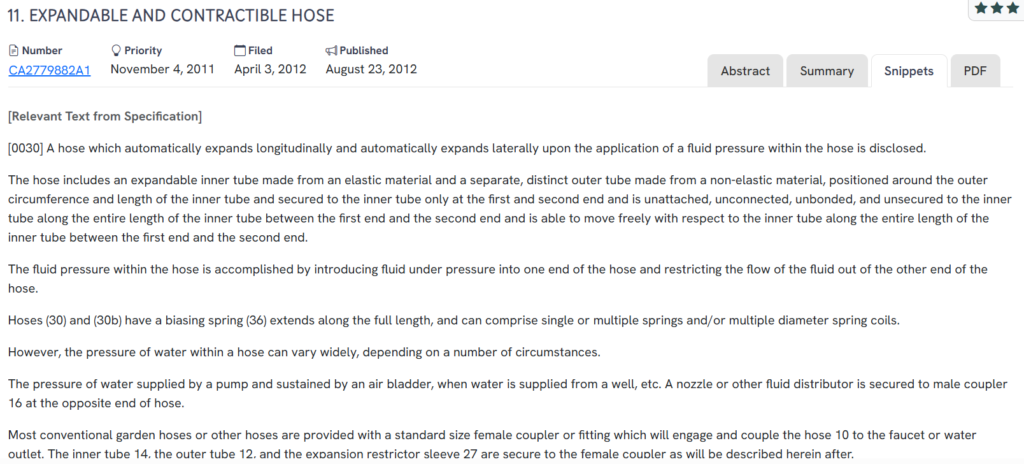
Source: GPS
What this patent introduces to the landscape?
- Independent dual-tube construction – An elastic inner tube is nested inside a non-elastic outer layer, joined only at the coupler ends.
- Expansion through fluid pressure and flow restriction – Expansion is achieved by applying fluid pressure and controlling outflow through a nozzle or other distributor.
- Optional spring-reinforced variants – The hose design can include biasing springs along the length for structural support and retraction assistance.
- Anti-kink and ice-tolerant performance – The smooth outer surface and elastic interior reduce kinking and allow for safe expansion even when internal fluid freezes.
- Universal coupling compatibility – Standard female and male couplers make it adaptable to common hose fittings.
How it connects to US9581272B2?
- Both systems rely on a non-bonded dual-layer structure, where only the ends of the inner and outer tubes are secured.
- They implement flow restriction near the outlet to build internal pressure and trigger expansion.
- Each design includes anti-kink functionality through material choice and layered construction.
Why this matters?
CA2779882A1 presents a near-parallel design philosophy to US9581272B2, focusing on pressure-based expansion, storage convenience, and durability. It adds depth to the pool of similar technologies addressing performance challenges in modern expandable hose systems. Material-driven innovation also plays a central role in biodegradable product design.
You can also see how controlled movement and stability are handled in consumer products in US10273075B2 and its sliding-drawer hat-storage design.
#3. NZ603211A
This New Zealand patent, NZ603211A, published in 2013, presents a hose system that expands in both length and width upon the application of water pressure. Built with an elastic inner tube and a non-elastic outer sleeve, the design focuses on maximizing flexibility, preventing rupture, and enabling compact storage when not pressurized.
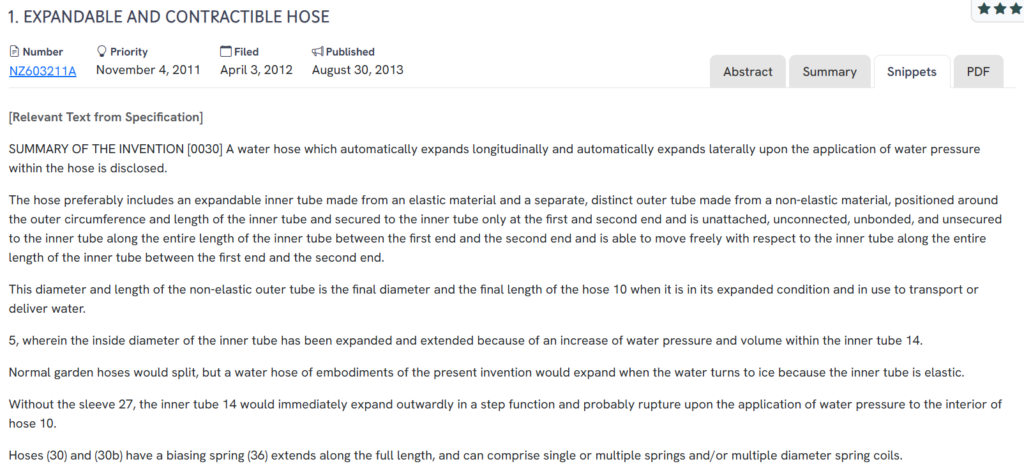
Source: GPS
What this patent introduces to the landscape?
- Elastic-non-elastic tube assembly – An elastic inner tube expands under pressure while the outer sleeve constrains the maximum dimensions of the hose.
- End-secured, freely moving tubes – The two tubes are only connected at the couplers, with the outer sleeve freely moving around the inner core along its entire length.
- Pressure management via nozzle restriction – The expansion is driven by internal water pressure, regulated by the nozzle or fluid distributor at the outlet.
- Anti-kink and freeze-resistant properties – The materials and configuration reduce kinking and allow the hose to tolerate freezing without splitting.
- Optional spring support – Biasing springs along the hose length can assist with retraction and maintaining structure.
How it connects to US9581272B2?
- Both designs use a dual-layer hose configuration, where expansion is enabled by fluid pressure and constrained by the non-elastic outer tube.
- The system’s feature unbonded midsections, allowing the outer sleeve to compress and fold during contraction.
- Each includes a flow regulation mechanism near the outlet that plays a critical role in maintaining pressure and achieving controlled expansion.
Why this matters?
NZ603211A strengthens the technical foundation behind expandable hose innovations. Its combination of pressure-driven mechanics, anti-kink design, and durable structure mirrors the core objectives of US9581272B2, adding further evidence of shared problem-solving strategies across similar systems.
Note: Portability depends on guided folding and safe storage. Expandable Hose Patent parallels US9867466B2’s cradle-and-guide design, showing how collapsible systems minimize strain in outdoor gear.
#4. US20180045340A1
This US patent, US20180045340A1, published in 2018, details a fluid-responsive garden hose that expands significantly, up to six times its contracted length, when pressurized liquid is introduced. The design emphasizes durability, user control, and resilience to pressure fluctuations and freezing conditions.
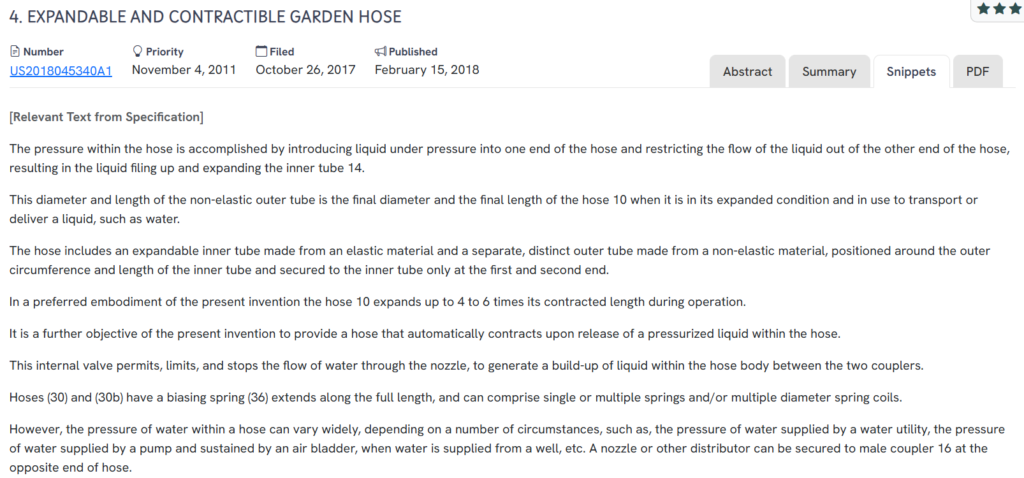
Source: GPS
What this patent introduces to the landscape?
- High-expansion dual-tube design – The hose includes an elastic inner tube housed inside a non-elastic outer sleeve, enabling expansion up to 4–6 times its original length.
- End-secured tube configuration – The inner and outer tubes are only joined at the inlet and outlet couplers, allowing free axial movement.
- Pressure control via internal valve – An internal valve at the nozzle end permits, limits, or stops water flow, helping build pressure within the hose.
- Freeze-tolerant elastic core – The hose can tolerate freezing water without splitting due to the elasticity of the inner tube.
- Biasing spring option – Springs may be integrated along the hose for structural reinforcement and shape memory.
How it connects to US9581272B2?
- Both inventions rely on a dual-layer, pressure-expanding hose architecture, using elastic and non-elastic materials.
- Each uses outlet-based flow restriction to generate and maintain internal pressure for controlled expansion.
- The hoses automatically contract when pressure is removed, offering convenience in storage and transport.
Why this matters?
US20180045340A1 extends the expandable hose concept with greater range and mechanical reinforcement. It echoes the design priorities found in US9581272B2, reinforcing a consistent engineering approach to solving problems of portability, pressure management, and hose longevity.
How to Find Related Patents Using Global Patent Search?

Understanding the broader innovation landscape around a patent can be essential for improving garden hose technology, optimizing fluid delivery systems, or designing next-generation expandable tubing. The Global Patent Search tool makes this process faster and more intuitive, helping users discover inventions with similar mechanics, material structures, or pressure regulation methods. Here’s how it works:
1. Enter the patent number into GPS: Type in a patent number like US9581272B2 into the GPS search bar. The tool converts it into a context-aware search that can also be refined using terms like “elastic tubing,” “flow restrictor,” or “dual-layer hose.”

2. Explore conceptual snippets: Instead of mapping each claim feature, GPS now highlights smart text snippets. These expose functional similarities in other patents, such as expansion control, hose reinforcement, or end-only coupling design.

3. Identify related inventions: The tool surfaces patents that share pressure-responsive expansion, layered tube construction, or kink-resistant formats, revealing how others have approached the same technical challenge.
4. Compare systems, not legal claims: GPS emphasizes how systems behave rather than how claims are written. This lets users analyze hose performance strategies and material innovations without needing a legal interpretation.
5. Accelerate cross-domain insights: Whether you’re designing consumer-grade hoses, industrial fluid delivery lines, or flexible tubing systems, GPS helps you scan comparable technologies and stay ahead of emerging design trends.
With this concept-driven approach, Global Patent Search equips engineers, product developers, and IP researchers with a practical view of related inventions, fueling faster decisions and smarter innovation paths.
Disclaimer: The information provided in this article is for informational purposes only and should not be considered legal advice. The related patent references mentioned are preliminary results from the Global Patent Search tool and do not guarantee legal significance. For a comprehensive related patent analysis, we recommend conducting a detailed search using GPS or consulting a patent attorney.

